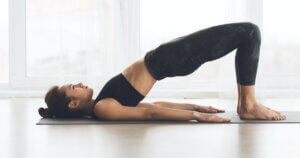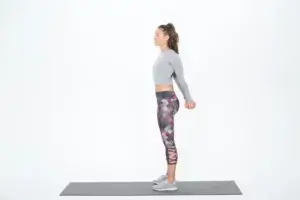Effective Back Posture Exercises
A good posture can help you become confident in your body and improve your health. But how to get a good posture and what are the suitable back posture exercises?
Maintaining good posture is crucial for anyone’s health and well-being. At the same time, a poor posture can lead to various issues, including back pain, muscle imbalances, and long-term spinal problems. Fortunately, there are several effective back posture exercises that can help enhance and maintain a healthy back. In this article, we will explore some of the best exercises and the common causes related to it. Also, we will get to know a few tips that could save you from injuring yourself in the posture exercises journey.
- Part 1. Why to Have a Good Posture
- Part 2.Common Causes for Bad Posture
- Part 3.Top 10 Effective Posture Exercises for Back
- Part 3.1 Wall Angels
- Part 3.2 Cat-Cow Stretch
- Part 3.3 Planks
- Part 3.4 Bridges
- Part 3.5 Child’s Pose
- Part 3.6 Thoracic Extension Exercises
- Part 3.7 Seated Leg Lifts
- Part 3.8 Chest Opener Stretch
- Part 3.9 Chin Tucks
- Part 3.10 Shoulder Blade Squeezes
- Part 4. Points To Remember for Posture Exercises
Why to Have a Good Posture
Before delving into the specific exercises, it’s essential to understand why good posture matters. When you maintain good posture, your body is in its most efficient and comfortable position.
The benefits of good posture include:
- Reduced Back Pain: One of the most immediate advantages of good posture is the relief from back pain. When your spine is properly aligned, it experiences less stress and strain, reducing the likelihood of discomfort.
- Improved Breathing: Proper posture allows your lungs to expand fully, enabling better airflow. This can help increase energy levels and overall well-being.
- Enhanced Confidence: Good posture can convey confidence and professionalism. It also affects how others perceive you. Standing tall and with your shoulders back can make you appear more assertive and self-assured.
- Spine Health: Maintaining good posture is crucial for spinal health. Poor posture can lead to issues like misaligned vertebrae, which can result in long-term back problems.
- Digestive Health: Proper alignment can benefit your digestive system. When you slouch or hunch over, your internal organs can be compressed, affecting digestion.
Common Causes for Bad Posture
There could be many reasons your posture can be bad and cause back and neck pain. Some of them are:
- Sedentary Lifestyle: Prolonged periods of sitting, often associated with desk jobs or excessive screen time, can lead to slouching and poor posture.
- Weak Core Muscles: The core muscles, like the abdominal and back muscles, support the spine. Weak core muscles can lead to postural issues.
- Muscle Imbalances: Imbalances between opposing muscle groups, such as tight chest and weak upper back muscles, can affect the straight back.
- Lack of Physical Activity: Inadequate physical activity and exercise can result in weak and inflexible muscles, making it harder to maintain good posture.
- Carrying Heavy Bags: Carrying heavy backpacks or shoulder bags can cause strain on the spine and lead to poor posture, especially in children and students.
- High Heels: Wearing high-heeled shoes can affect the body’s alignment, leading to an exaggerated curve in the lower back and forward head posture.
- Stress and Emotional Factors: High-stress levels can lead to tension and muscle tightness, affecting posture.
Now we know what could be the possible causes that are making our posture bad and affecting our overall health.
Top 10 Effective Posture Exercises for Back
Here are 10 effective posture exercises that can help you improve and maintain a healthy back:
Wall Angels
Wall angels exercise helps improve shoulder mobility and strengthen the upper back muscles, promoting proper alignment of the shoulders. Mainly, it is an upper back posture exercise.
- Stand with your back against a wall.
- Place your feet shoulder-width apart and slightly away from the wall.
- Extend both arms straight to the sides forming a shape of “T”.
- Lift your arms slowly above your head while keeping them pressed against the wall.
- Lower your arms back down to the initial position.
Repeat these steps for several sets.

Cat-Cow Stretch
The cat-cow stretch helps improve the flexibility of your spine and promotes a healthy range of motion, reducing the risk of stiffness and pain.
- Start on your hands and knees in a tabletop position.
- Inhale and arch your back (Cow Pose).
- Exhale and round your back (Cat Pose).
- Continue to flow between these two stretches for a minute or two.

Planks
Planks strengthen your core muscles, which are essential for maintaining proper posture and supporting your lower back.
- Begin in a push-up position with your forearms on the ground.
- Keep your body in a straight line from head to heels.
- Hold this position for at least 30 seconds to 1 minute.
- As you progress, increase the time you hold the plank.

Bridges
Bridges work on your glutes, lower back, and core muscles, helping to stabilize your spine and improve your posture.
- First, lie on your straight back with your knees bent and feet flat on the floor.
- Make sure to contract your core muscles and slowly raise your hips off the ground.
- Hold the bridge position for a few seconds and then lower your hips back down.
- Repeat this exercise for several sets.

Child’s Pose
A child’s pose is a great exercise to release lower back tension and improve flexibility.
- In a kneeling position, ensure that your big toes are touching while your knees are apart.
- Extend your arms out in front of you, reaching towards the floor.
- Relax in this position, feeling the stretch along your spine and lower back.

Thoracic Extension Exercises
The Thoracic Extension exercises improve your body’s functionality and mobility. It helps reduce the back and neck pain.
- Sit or stand with your back straight.
- Place your hands behind your head.
- Gently arch your upper back, looking upward.
- Hold for a few seconds, then return to a neutral position.
- Repeat this motion to improve thoracic spine mobility.

Seated Leg Lifts
The seated leg lift is a lower back exercise that is beneficial to improve mobility in the lower abdominal muscles, hamstrings, and quads.
- To begin, sit on the edge of a sturdy chair with your back straight.
- Keep your legs straight and lift one leg at a time.
- Hold each leg up for a few seconds and then lower it.

Chest Opener Stretch
You can do the chest opener stretch if you work for prolonged hours sitting at a desk. It is an upper back posture exercise that could help to strengthen the muscles of the back and front of the shoulders.
- Stand with your feet shoulder-width apart.
- Interlace your fingers behind your back.
- Straighten your arms and lift them slightly, opening your chest.
- Hold for 15-30 seconds.

Chin Tucks
Chin Tucks help to reduce headaches, and neck tension, and improve flexibility.
- Sit or stand with your back straight.
- You should gently bring your chin towards your chest.
- Hold for a few seconds, then release.
- Repeat this exercise to strengthen your neck muscles and improve head alignment.

Shoulder Blade Squeezes
The Shoulder Blade squeeze is a great exercise to maintain upper back posture and strengthen the shoulder blade muscles.
- Stand or sit with your arms down at your side.
- Try to squeeze your shoulder blades together as if trying to hold something between them.
- Hold on to this position for a few seconds, and then relax.
- Repeat this motion to improve upper back strength and posture.

Incorporating these exercises into your daily routine and paying attention to your posture throughout the day can help you attain and maintain good posture for life.
Points To Remember for Posture Exercises
Improving posture with back and posture exercises takes time and effort. Remember the following points before starting and while doing the posture exercises.
- Perform these posture exercises regularly and consistently to maintain a good posture.
- Avoid sitting for long hours on a laptop or at the desk.
- If you are not getting results for weeks, consult your doctor or physician, as he would suggest the appropriate workout plan for you.
- Avoid wearing heels and wear comfortable shoes.
- Add nutritious foods to your diet and keep yourself hydrated.
- Take the help of a trainer if you are not able to exercise properly.
Conclusion
A good posture is essential for maintaining good health, and these exercises and important tips can help you maintain it. By investing time and effort in these back posture exercises, you can reduce back pain, improve your posture, gain confidence, as well as build your strength.
You must seek professional healthcare guidance whenever you start following a workout plan. Remember to stay consistent and follow the tips given in this article, as a good posture is the foundation of your overall well-being.
